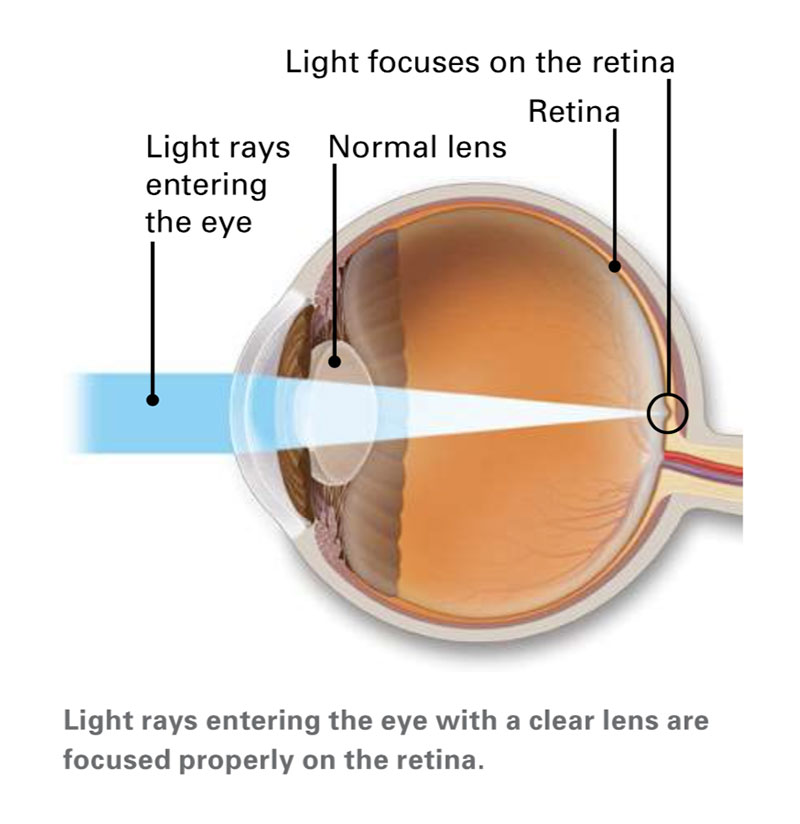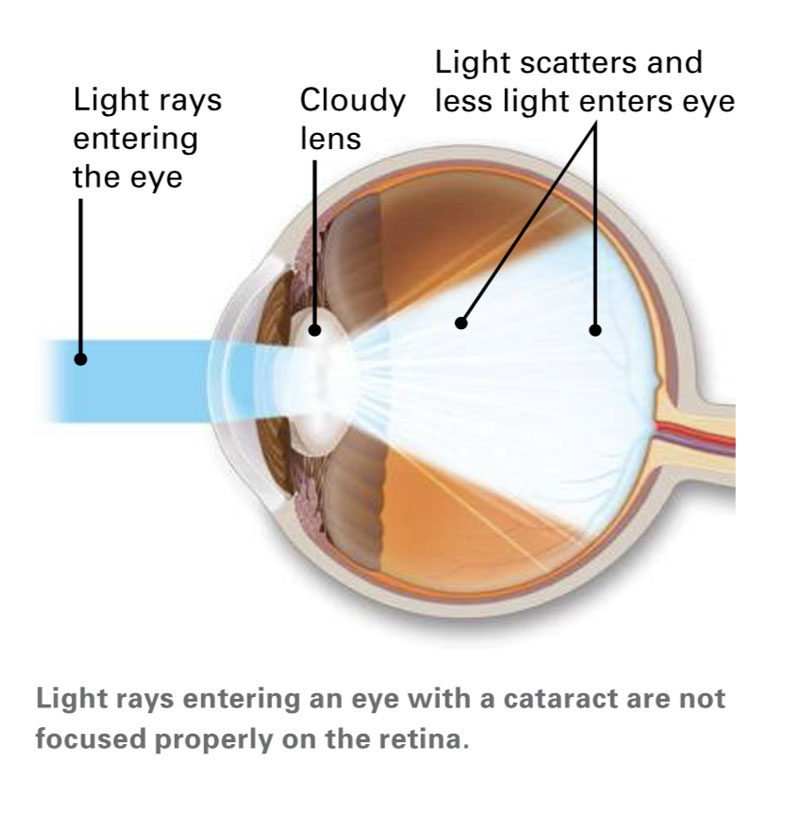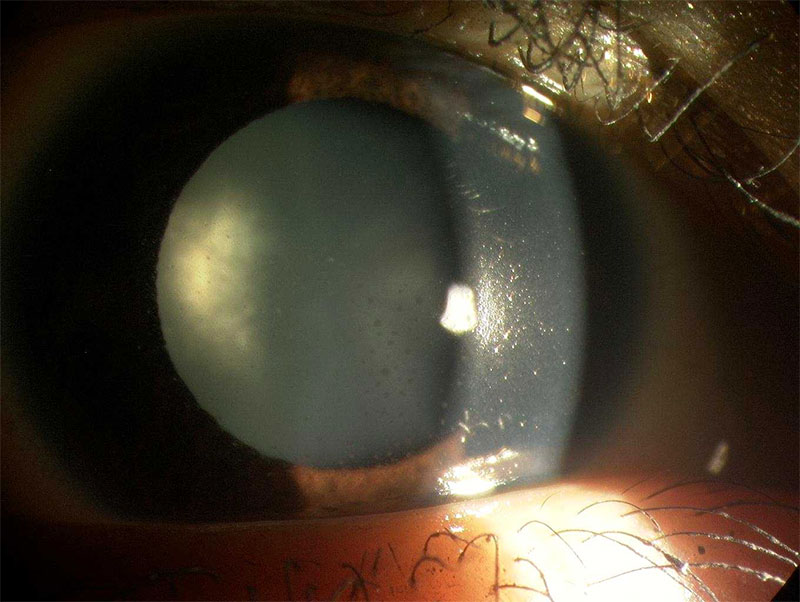Cataract
Cataracts are a very common reason people lose the quality of their eye sight, but they can be safely and effectively treated. Dr Chang provides a personalised treatment plan for his patients carefully explaining all the options.
What is a cataract?
Inside our eyes, we have a natural lens which focuses light rays that come into the eye onto the retina to help us see clearly (think of it similar to how the lens works in a camera). This lens should be transparent in good health giving nice and clearly focused vision. When you develop a cataract, your lens gradually becomes cloudy. It is like looking through a foggy or dirty glasses lens or window. Things look blurry, hazy or less colourful with a cataract. Cataracts are a very common reason people lose the quality of their eye sight, but they can be safely treated.

Image from American Academy of Ophthalmology: Cataract Surgery

Image from American Academy of Ophthalmology: Cataract Surgery
What causes cataracts?

Cataract (posterior subcapsular type) in a patient with uveitis (as seen on specialised microscope to examine the eye).
The most common cause of cataracts is ageing. Due to inevitable ageing of the proteins in the natural lens that starts around 40-50 years of age, the lens starts to gradually get yellow and cloudy. Other causes of cataracts include: having spent a lot of time in the sun, especially without sunglasses that protect your eyes from damaging ultraviolet (UV) rays; use of certain medications such as corticosteroids whether it be by tablet, inhaler or eye drops; certain medical problems such as diabetes and uveitis (intraocular inflammation), and having had previous eye injury or eye surgery. Some of these can cause cataract even in younger people.
What are symptoms of a cataract?
Since cataracts usually develop slowly over a period of years, the symptoms are usually gradual and insidious in onset. As the cataract becomes more significant and symptomatic, you may notice some of the following changes in your eye sight:
- Blurry vision that is not much improved with new or stronger glasses prescription
- Difficulty reading the subtitles or sports score on the TV
- Glare when driving and ghosting or haloes around oncoming headlights
- Difficulty reading the fine print such as the newspaper or needing more light when you read
- Difficulty playing sports such seeing the golf ball on sunny or overcast days due to glare
- Seeing colours as faded, dull or more yellowish instead of the actual vibrant colour
How are cataracts diagnosed?
Cataracts are diagnosed by your eye health professional such as optometrist or ophthalmologist (eye doctor) using specialised equipment. Usually, pupil dilating eye drops are needed to fully examine the lens and with a special illuminating microscope, the eye specialist will be able to diagnose the type and severity of cataract. Not all cataracts are the same, and there are in fact several different types of cataracts, such as nucleosclerotic, cortical or posterior subcapsular cataracts. They can have differing impacts on your vision as well as different rates of progression. Although most cataracts develop gradually over a period of years, some can develop more quickly within months and result in a relatively quick visual deterioration.
It is very important that your eye specialist ensures that there are no other eye conditions such as macular degeneration, glaucoma, or diabetic retinopathy that may be causing your visual difficulties instead of, or in addition to your cataract. This will determine what treatment options are best for you and for some patients, other eye treatments may be more important before cataract surgery can be safely offered. Dr John Chang provides a personalised treatment plan for his patients, carefully explaining all the options.
How are cataracts treated?
Eye surgery is the only definitive treatment for cataracts where the cloudy lens (cataract) is removed and then replaced with an artificial lens implant. This new lens is called an intraocular lens (or IOL). When you decide to have cataract surgery, Dr Chang will talk to you about the various different types of IOLs and which one may be the best option for you. Cataract operation is a very effective and safe procedure that is performed as a day surgery and which cures you of your cataract. Once removed, cataracts do not “grow back” again.
When are my cataracts “ready” or suitable for cataract surgery?
Not every patient with cataracts need surgery when initially diagnosed. If your visual symptoms are not bothering you very much, you don’t have to have cataract operation. However, you should consider surgery when cataracts are causing noticeable visual symptoms that keeps you from doing things you want or need to do such as driving, reading, watching the TV/computer screen, or your leisure activities such as knitting or playing sports. For some people, their vision drops below practical requirement for their driver’s license, in which case cataract surgery is needed as a high priority should they want to continue to drive safely.
You and your eye surgeon should discuss your visual symptoms and lifestyle needs. Together you can decide whether you are ready for cataract surgery. This requires a thorough eye examination as well as consideration of any co-existing eye conditions, your visual needs and wants, and a tailored, personalized advice from your eye specialist.
Learn more about Cataract Surgery at Eastwood Eye Specialists
For more information on cataract surgery, please call Eastwood Eye Specialists for an appointment.